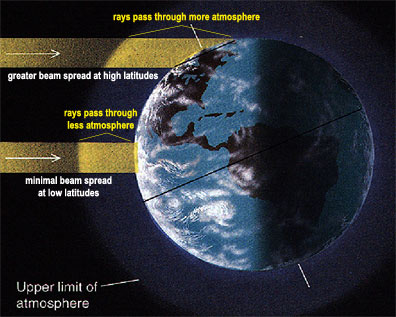How latitude influences insolation
Owing to the revolution of the earth, summer days are longer nearer the poles; so also are winter nights. Close to the equator, daytime, or the duration of insolation is nearly always twelve hours all year round. It is only two days out of the 364 days of the year that daytime and nighttime are 12 hours each everywhere on the earth. So insolation varies with latitude.
Again, as a result of the curvature of the earth, the sun shines directly nearer the equator and obliquely nearer the poles. Direct rays generate more intense insolation and therefore greater heat than oblique rays. Reasons for these are as follows:

Credit
- Direct rays nearer the equator have less area to heat on the surface of the earth, while the same quantity of oblique rays farther away from the equator spreads its heat over a wider area.
- Direct rays of the sun passes through lesser thickness of the atmosphere and therefore lose less heat in transit by atmospheric reflection and scattering than oblique rays. So, the balance of the solar energy that arrives the earth is more in the case of the direct rays at the equator, than the oblique rays at the higher latitudes.
Conclusion
For these reasons, it is warmer nearer the equator than nearer the poles, and this explains why it is warmer in Nigeria than in Norway or Other temperate countries.
Reference
http://www.shsu.edu/~dl_www/bkonline/131online/f02latitude/02index.htm
